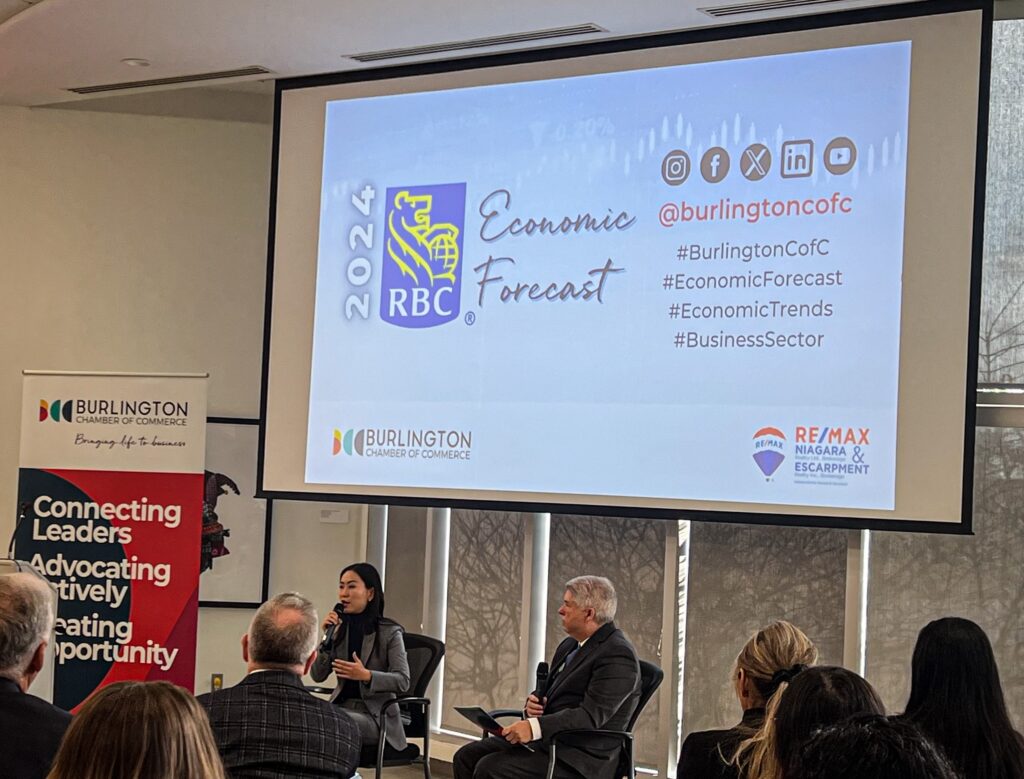The 2024 RBC Economic Forecast was held on November 30, 2023, and it featured economist Claire Fan, who provided expert perspectives on key trends and the priorities in the year ahead.
Joining RBC in 2019, Fan focuses on macro-economic analyses in Canada, examining key areas of growth, inflation projections, economic trends, labour market, and the Gross Domestic Product (GDP).
According to Fan, the third quarter GDP in Canada was a small negative, but the second quarter was revised to a small positive, avoiding a technical recession as of the current day. However, current conditions — an economic contraction — could indicate a mild recession.
From a GDP perspective in Canada, the trends appear to be flattening out, slowing down the economy as expected, says Fan. With that, however, there is a deterioration in the labour market that is to be expected, and we are already seeing a pretty substantial increase in the unemployment rate across the country.
“This is how we characterize this upcoming downturn as a mild recession, meaning that we really don’t expect huge deterioration or rapid slowdown activities,” says Fan.
According to RBC, this all started with the inflation story. Looking back at the supply-chain issues that began back in 2020 in China, the flow of consumer goods were affected globally. Then, 2021 brought drought conditions in the prairie provinces in Canada, which subsequently increased food inflation. The Russian invasion into Ukraine in 2022 drove up agricultural and energy commodity prices, further perpetuating food inflation rates. There is no doubt that this inflation story has many facets.
But it’s not all food inflation.
There was a surge in lumber prices and home renovation supplies, and upon pandemic restrictions lifting, the demand for car rentals and domestic travel increased substantially across Canada and the United States, which begins to demonstrate that this inflation is not unique to food. After observing these surges, the Bank of Canada started to increase the interest rates in March of 2022. This is arguably one of the oldest tools in the playbook to slow down the economy. Simply put — the supplies were not keeping up with the demands, spread across a wide array of goods and services. The intention has been to cool the economy and bring it back to a state of equilibrium, and through these rapid and aggressive interest rate increases, consumers are only now starting to see its effects, according to Fan.
Prices and consumer behaviours haven’t returned to pre-pandemic rates. Cost pressures and lower consumer demand have not returned to those rates Canada has historically experienced, which may indicate that businesses will find both less need and reduced capability to raise prices at this time.
“All that, in short, sounds like lower inflation to me,” says Fan.
While families have had to make concessions on what they spend their money on, because the demands are being pulled back, we may see the inflation rate start to come down. Groceries, gasoline, and servicing debt have been the heavy hitters when it comes to inflation rates, impacting many families across Canada.
Inflation expectations have been moderating the behaviour of consumers and businesses since the beginning of 2023. However, there have been indications of inflation pressures easing over the months of September and October, as reported by RBC, which is a positive sign as we move into 2024.
Current economic conditions indicate that retail consumerism has substantially pulled back, despite population growth across the country.
One of Fan’s key focuses is the GDP rate in Canada, and considering the GDP at an aggregate level, quarter over quarter, it has been flat this year. However, if you consider the GDP per capita, this third quarter of the year is the fifth consecutive quarter that the GDP has declined in Canada, which suggests that Canada has been in a recession on a per capita level for some time.

Population growth has had huge implications on the labour market. Unemployment rates are not rising as a result of job loss, but rather an increase in the pool of people seeking employment. This demonstrates strong business growth, but with a higher unemployment rate; businesses are still hiring, but it is taking a lot longer to find these jobs.
In addition, 60% of businesses reported a decline in sales, which suggests that consumers have pulled back considerably. As a result, the demand for labour is simply not there, driving up the unemployment rates — which isn’t great, says Fan.
“Are we on track for this mild recession? The answer is basically yes,” says Fan. “From an unemployment rate perspective, we’re tracking on the lower end, and from the GDP per capita perspective, we’re tracking on the higher end.”
Fan does follow this up to say that perhaps instead of calling it a mild recession, it should be perceived as a broader pull-back in the Canadian economy, a slowing demand in the labour market conditions.
Still, some economists wonder: have we done enough to slow inflation down?
Fan seems to think so, and suggests that this is a good time for the Bank of Canada to feel confident in its efforts to slow the economy down, and that we don’t need to go any further.
The housing boom in 2020 and 2021 will see many more mortgage renewals on the horizon in 2025 and 2026. Approximately 40% of homeowners have already felt the sting of current-day mortgage renewals, with an estimated 60% left to feel the consequences of these aggressive interest rate hikes, according to RBC.
Aggressive inflationary increases and interest rate hikes can indicate critical downside risks.
Prior to the 1990s, the debt-to-income ratio was about 90%. Prior to the global financial crisis, the ratio was around 150%. Currently, RBC is recording 180% for the debt-to-income ratio. The debt servicing cost is at a record level. This makes households all the more vulnerable in terms of a labour market downturn, with critical consequences if family income-earners were to lose employment. These are some of the downside risks that RBC continues to track.
These economic trends are certainly not unique to Canada, says Fan: we are seeing similar trends across Europe.
However, China is having the opposite problem. They are experiencing deflation because consumer buying habits have been very sluggish. As a result, there is a lack of confidence in government policies, further fueling a decline in leveraging the economy through consumerism.
Fan wraps up the forecast by touching on the housing market, and based on the data that RBC presented from a rates-outlook perspective, she believes that the Bank of Canada will be done with their interest rate increases at this point.
On December 6, 2023, the Bank of Canada announced that it will hold its key interest rate steady at 5% in its final decision for 2023.
In terms of cuts, RBC expects that the Bank of Canada will start cutting the rate in the third quarter of 2024. They forecast rates to be lower than 3% by the end of 2024, but this is tempered with some uncertainty from the federal reserves side of the forecast. RBC expects to see the unemployment rate to start peaking in the second quarter of 2024, which may drive the urgency to reduce the interest rate out of necessity.
The 2024 RBC Economic Forecast was held on November 30, 2023, and was hosted by the Burlington Chamber of Commerce at the Art Gallery of Burlington.




